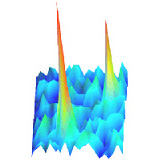Matrix stiffness affects spheroid invasion, collagen remodeling and the effective reach of stress into the ECM.
Klara Beslmüller, Rick Rodrigues de Mercado, Gijsje H. Koenderink, Erik H.J. Danen, Thomas Schmidt
The extracellular matrix (ECM) provides structural support to cells thereby forming a functional tissue. In cancer, the growth of the tumor creates an internal mechanical stress which, together with remodeling activity of tumor cells and fibroblasts, alters the ECM structure leading to an increased stiffness of the pathological ECM. The enhanced ECM stiffness in turn stimulates tumor growth, activates tumor-promoting fibroblasts and tumor cell migration, leading to metastasis and an increased therapy resistance. The connection between internal tumor stress, ECM stiffness, ECM remodeling, and cell migration are unresolved. Here we used 3D ECM-embedded spheroids and hydrogel-particle stress sensors, to quantify and correlate internal tumor-spheroid pressure, ECM stiffness, ECM remodeling, and tumor cell migration. 4T1 breast cancer spheroids and SV80 fibroblast spheroids showed increased invasion – described by area, complexity, number of branches and branch area – in a stiffer, cross-linked ECM. On the other hand, changing the ECM stiffness only minimally changed the radial alignment of fibers but highly changed the amount of fibers.. For both cell types, the pressure measured in spheroids gradually decreased as the distance into the ECM increased. For 4T1 spheroids, increased ECM stiffness resulted in a further reach of mechanical stress into the ECM which, together with the invasive phenotype, was reduced by inhibition of ROCK-mediated contractility. By contrast, such correlation between ECM stiffness and stress-reach was not observed for SV80 spheroids. Our findings connect ECM stiffness with tumor invasion, ECM remodeling, and the reach of tumor-induced mechanical stress into the ECM. Such mechanical connections between tumor and ECM are expected to drive early steps in cancer metastasis.
bioRxiv 2025/643241: [DOI]

